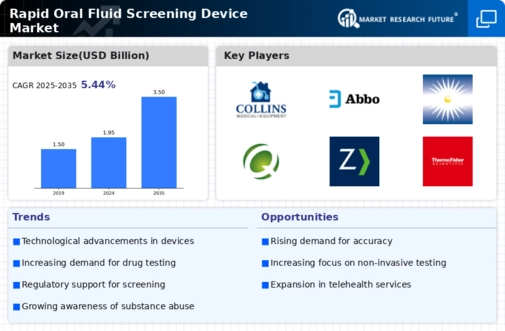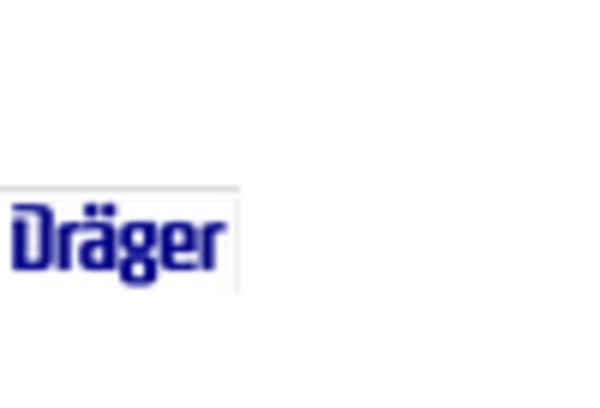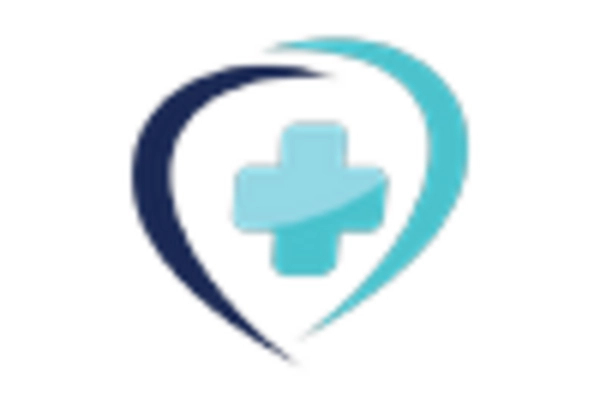Supportive Regulatory Frameworks
Supportive regulatory frameworks are emerging as a key driver in the Rapid Oral Fluid Screening Device Market. Governments and regulatory bodies are increasingly endorsing the use of oral fluid testing as a legitimate method for drug screening. This endorsement not only legitimizes the technology but also encourages its adoption across various sectors. Recent regulations have streamlined the approval processes for new devices, facilitating quicker market entry. As a result, the market is expected to experience a growth rate of approximately 9% in the next few years. This supportive environment indicates that the Rapid Oral Fluid Screening Device Market is likely to flourish as more manufacturers and healthcare providers embrace these regulatory changes.
Expansion of Drug Testing Programs
The expansion of drug testing programs across various sectors, including workplaces and educational institutions, serves as a significant driver for the Rapid Oral Fluid Screening Device Market. With increasing concerns over substance abuse and its impact on productivity and safety, organizations are implementing more rigorous testing protocols. The market for oral fluid testing is expected to witness a surge, with estimates suggesting a growth rate of around 10% annually. This growth is fueled by the advantages of oral fluid testing, such as rapid results and ease of administration, making it a preferred choice for many organizations. Consequently, the Rapid Oral Fluid Screening Device Market is poised to benefit from this trend as more entities recognize the importance of effective drug testing.
Rising Awareness of Health and Safety
The growing awareness of health and safety issues among the public is a significant driver for the Rapid Oral Fluid Screening Device Market. As individuals become more conscious of the implications of drug use and its effects on health, there is an increasing demand for reliable testing methods. This heightened awareness is prompting organizations to implement regular screening programs, thereby boosting the market for oral fluid testing devices. Data suggests that the health and safety sector is likely to see a growth rate of around 12% in the coming years, as more entities prioritize the well-being of their employees and stakeholders. Consequently, the Rapid Oral Fluid Screening Device Market stands to gain from this trend as it aligns with the growing emphasis on health and safety.
Increasing Demand for Non-Invasive Testing
The rising preference for non-invasive testing methods is a notable driver in the Rapid Oral Fluid Screening Device Market. As healthcare providers and patients alike seek alternatives to traditional blood tests, oral fluid screening devices are gaining traction. This shift is partly due to the convenience and comfort associated with oral fluid collection, which eliminates the need for needles. Market data indicates that the demand for non-invasive testing is projected to grow at a compound annual growth rate of approximately 8% over the next five years. This trend suggests that the Rapid Oral Fluid Screening Device Market is likely to expand as more healthcare facilities adopt these technologies to enhance patient experience and streamline testing processes.
Technological Innovations in Screening Devices
Technological innovations play a crucial role in shaping the Rapid Oral Fluid Screening Device Market. Advances in detection technologies, such as improved sensitivity and specificity, are enhancing the reliability of oral fluid tests. These innovations not only improve the accuracy of results but also reduce the time required for testing, making them more appealing to healthcare providers. Market analysis indicates that the introduction of new devices with advanced features is likely to drive market growth, with a projected increase in market size by approximately 15% over the next few years. As technology continues to evolve, the Rapid Oral Fluid Screening Device Market is expected to adapt, offering more efficient and effective solutions for various testing needs.


















Leave a Comment